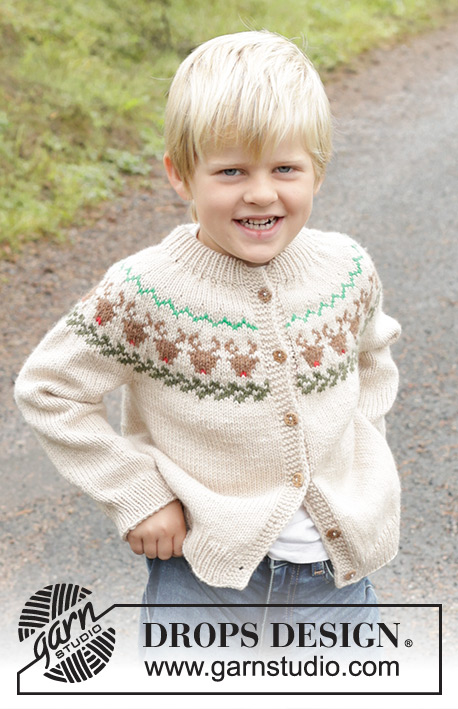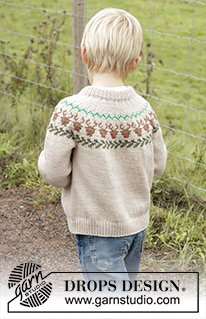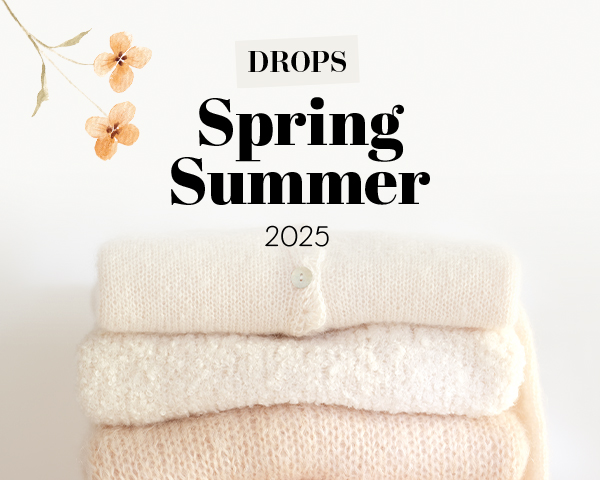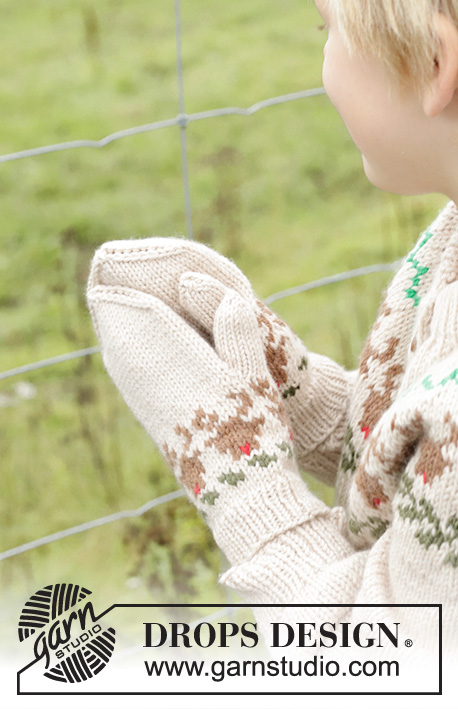Comments / Questions (1)
![]() Pradnya wrote:
Pradnya wrote:
Can I knit on straight needles? not comfortable on circular or two way needles.Thanking you
28.12.2023 - 08:12DROPS Design answered:
Dear Pradnya, please read the following lesson on how to adapt for straight needles: https://www.garnstudio.com/lesson.php?id=13&cid=19. Take into account that the raglan may be difficult to adjust to straight needles. Happy knitting!
28.12.2023 - 20:09
Reindeer Dance Cardigan#reindeerdancecardigan |
|||||||||||||||||||
 |
 |
||||||||||||||||||
Knitted jacket for children in DROPS Daisy. The piece is worked top down with double neck, round yoke and multi-colored reindeer pattern. Sizes 2 – 14 years.
DROPS Children 47-17 |
|||||||||||||||||||
|
------------------------------------------------------- EXPLANATIONS FOR THE PATTERN: ------------------------------------------------------- GARTER STITCH (worked back and forth): Knit all rows. 1 ridge in height = knit 2 rows. BANDS: AT BEGINNING OF ROW: Slip 1 stitch purl-wise with strand in front, knit 1, work 4 garter stitches. AT END OF ROW: Work until there are 6 stitches left, work 4 garter stitches, slip 1 stitch purl-wise with strand in front, knit 1. ELEVATION: To make the jacket higher at the back when working a round yoke, work an elevation. Skip this section if you do not want an elevation. Insert 1 marker in the middle stitch on the row. Start from the right side and knit 11-12-13-14-15-16-17 stitches past the marker-stitch, turn, tighten the strand and purl 23-25-27-29-31-33-35. Turn, tighten the strand and knit 34-37-40-43-46-49-52, turn, tighten the strand and purl 45-49-53-57-61-65-69. Turn, tighten the strand and knit 56-61-66-71-76-81-86, turn, tighten the strand and purl 67-73-79-85-91-97-103. Turn, tighten the strand and knit to the end of the row, turn and purl 1 row (working band as before). Continue the yoke. PATTERN: See diagram A.1. Choose diagram for your size. The whole pattern is worked in stockinette stitch. KNITTING TIP: To avoid the knitting gauge losing its elasticity when working pattern, it is important that the strands at the back are not tight. Use a size larger needle when working pattern if the piece becomes tight. INCREASE TIP (evenly spaced): Increase 1 stitch by making 1 yarn over. On the next round knit the yarn overs twisted to avoid holes. Then work the new stitches in stockinette stitch. BUTTONHOLES: Work buttonholes on the right band (when the garment is worn). Work from the right side when there are 4 stitches left on the row as follows: Make 1 yarn over, knit 2 together, slip 1 stitch purl-wise with the strand in front, knit 1. On the next row (wrong side), knit the yarn over to leave a hole. The first buttonhole is worked on the first row from the right side after the neck. The other 5-5-5-5-6-6-6 buttonholes are then worked with approx. 5½-6½-7-8-7-7½-7½ cm = 2⅛"-2½"-2¾"-3⅛"-2¾"-2⅞"-2⅞" between each one. The bottom buttonhole is worked in the transition between the stockinette stitch and the rib. DECREASE TIP (for sleeves): Decrease 1 stitch on each side of the marker-thread as follows: Work until there are 3 stitches left before the marker-thread, knit 2 together, knit 2 (marker-thread sits between these 2 stitches), slip 1 stitch knit-wise, knit 1 and pass the slipped stitch over the knitted stitch (2 stitches decreased). ------------------------------------------------------- START THE PIECE HERE: ------------------------------------------------------- JACKET – SHORT OVERVIEW OF THE PIECE. The neck and yoke are worked back and forth with circular needle, from mid front and top down. The yoke is divided for body and sleeves and the body continued back and forth with circular needle. The sleeves are worked in the round with double pointed needles. DOUBLE NECK: Cast on 81-85-87-89-91-95-97 stitches with color marzipan DROPS Daisy, using circular needles size 3 and 4 MM = US 6 held together. Remove the needle size 4 MM = US 6 (this gives you an elastic cast-on edge). Work as follows from the right side: 1 GARTER STITCH – read description above, * knit 1, purl 1 *, work from *-* until there are 2 stitches left, knit 1, 1 garter stitch. Continue this rib. When the neck measures 3 cm = 1⅛", cast on 5 stitches at the end of the next 2 rows = 91-95-97-99-101-105-107 stitches. Continue the rib with 6 BAND stitches on each side – read description above. When the neck measures 6 cm = 2⅜" and the next row is from the right side, fold the neck double to the inside and work as follows: 6 band stitches as before, continue the rib but working every 2nd stitch together with its corresponding stitch on the cast-on edge, and until there are 6 stitches left, 6 band stitches as before. You now have a double neck. YOKE: Change to circular needle size 4 MM = US 6. Purl 1 row from the wrong side and increase 24-26-28-30-32-32-34 stitches evenly spaced – read INCREASE TIP (do not increase over the bands, which are worked as before) = 115-121-125-129-133-137-141 stitches. Insert 1 marker after the band at the beginning of the row. The yoke is measured from this marker. You can now work an ELEVATION at the back – read description above. Skip this section if you do not want an elevation. Work stockinette stitch back and forth with 6 band stitches on each side as before. REMEMBER THE KNITTING GAUGE and BUTTONHOLES on right band – read description above. When the yoke measures 2-2-3-3-4-4-5 cm = ¾"-¾"-1⅛"-1⅛"-1½"-1½"-2" from the marker, increase 26-28-32-36-40-44-48 stitches evenly spaced (do not increase over the bands) = 141-149-157-165-173-181-189 stitches. Work until the yoke measures 3-3-4-4-5-5-6 cm = 1⅛"-1⅛"-1½"-1½"-2"-2"-2⅜" from the marker – and the next row is from the right side. Now work A.1 and increase as described below – read KNITTING TIP and PATTERN above. The bands are worked in color marzipan. Work 6 band stitches as before, A.1 16-17-18-19-20-21-22 times, work the first stitch in A.1 so the pattern is symmetrical, 6 band stitches as before. Continue this pattern. AT THE SAME TIME, on each row with an arrow in the diagram increase from the right side as follows (do not increase over the bands): ARROW-1: Increase 32-32-32-40-40-40-48 stitches evenly spaced = 173-181-189-205-213-221-237 stitches. ARROW-2: Increase 24-24-32-32-40-40-40 stitches evenly spaced = 197-205-221-237-253-261-277 stitches. ARROW-3: Increase 16-16-16-16-16-16-16 stitches evenly spaced = 213-221-237-253-269-277-293 stitches. ARROW-4: Increase 4-8-8-4-0-4-0 stitches evenly spaced = 217-229-245-257-269-281-293 stitches. When A.1 is finished, continue with stockinette stitch in color marzipan and 6 band stitches on each side as before. DIVIDE FOR BODY AND SLEEVES: When the yoke measures 13-14-15-16-17-18-19 cm = 5⅛"-5½"-6"-6¼"-6¾"-7"-7½" from the marker, work as follows: 36-38-41-43-45-47-49 stitches as before (front piece), place the next 42-44-46-48-50-52-54 stitches on a thread for the sleeve, cast on 8 stitches (in side under sleeve), work 61-65-71-75-79-83-87 stockinette stitches (back piece), place the next 42-44-46-48-50-52-54 stitches on a thread for the sleeve, cast on 8 stitches (in side under sleeve), work the last 36-38-41-43-45-47-49 stitches as before (front piece). The body and sleeves are finished separately. The piece is now measured from here. BODY: = 149-157-169-177-185-193-201 stitches. Work stockinette stitch back and forth with color marzipan and 6 band stitches on each side as before for a further 15-18-21-24-25-26-27 cm = 6"-7"-8¼"-9½"-9¾"-10¼"-10⅝". Change to circular needle size 3 MM = US 2.5. Knit 1 row from the right side and increase 14-14-14-14-16-16-18 stitches evenly spaces (do not increase over the bands) = 163-171-183-191-201-209-219 stitches. Work as follows from the wrong side: 6 band stitches as before, * purl 1, knit 1 *, work from *-* until there are 7 stitches left, purl 1, 6 band stitches as before. Continue this rib for 4 cm = 1½". Bind off a little loosely. The jacket measures approx. 36-40-44-48-50-52-54 cm = 14¼"-15¾"-17¼"-19"-19¾"-20½"-21¼" from the shoulder. SLEEVES: Place the 42-44-46-48-50-52-54 stitches from the thread on the one side of the piece on double pointed needles size 4 MM = US 6 and knit up 1 stitch in each of the 8 stitches cast on under the sleeve with color marzipan = 50-52-54-56-58-60-62 stitches. Insert a marker-thread in the middle of the new stitches under the sleeve and allow it to follow your work onwards, it is used when decreasing under the sleeve. Start at the marker-thread and work stockinette stitch in the round. When the sleeve measures 2-2-3-4-4-4-4 cm = ¾"-¾"-1⅛"-1½"-1½"-1½"-1½", decrease 2 stitches under the sleeve – read DECREASE TIP. Decrease like this every 3-3½-4-4½-5-6-7 cm = 1⅛"-1¼"-1½"-1⅝"-2"-2⅜"-2¾" a total of 6 times = 38-40-42-44-46-48-50 stitches. Continue working until the sleeve measures 18-22-26-30-34-38-41 cm = 7"-8¾"-10¼"-11¾"-13⅜"-15"-16⅛" from the division (or to desired length. There is approx. 4 cm = 1½" left). Change to double pointed needles size 3 MM = US 2.5. Knit 1 round and increase 4-4-4-4-4-6-6 stitches evenly spaced = 42-44-46-48-50-54-56 stitches. Work rib (knit 1, purl 1) for 4 cm = 1½". Bind off a little loosely. The sleeve measures approx. 22-26-30 -34-38-42-45 cm = 8¾"-10¼"-11¾"-13⅜"-15"-16½"-17¾" from the division. Work the other sleeve in the same way. ASSEMBLY: Sew the openings on the neck with small stitches. Sew the buttons onto the left band. |
|||||||||||||||||||
Diagram explanations |
|||||||||||||||||||
|
|||||||||||||||||||

|
|||||||||||||||||||

|
|||||||||||||||||||
Have you finished this pattern?Tag your pictures with #dropspattern #reindeerdancecardigan or submit them to the #dropsfan gallery. Do you need help with this pattern?You'll find 30 tutorial videos, a Comments/Questions area and more by visiting the pattern on garnstudio.com. © 1982-2025 DROPS Design A/S. We reserve all rights. This document, including all its sub-sections, has copyrights. Read more about what you can do with our patterns at the bottom of each pattern on our site. |
|||||||||||||||||||





















































































Post a comment to pattern DROPS Children 47-17
We would love to hear what you have to say about this pattern!
If you want to leave a question, please make sure you select the correct category in the form below, to speed up the answering process. Required fields are marked *.